2005 CHEVROLET AVEO child seat
[x] Cancel search: child seatPage 50 of 316
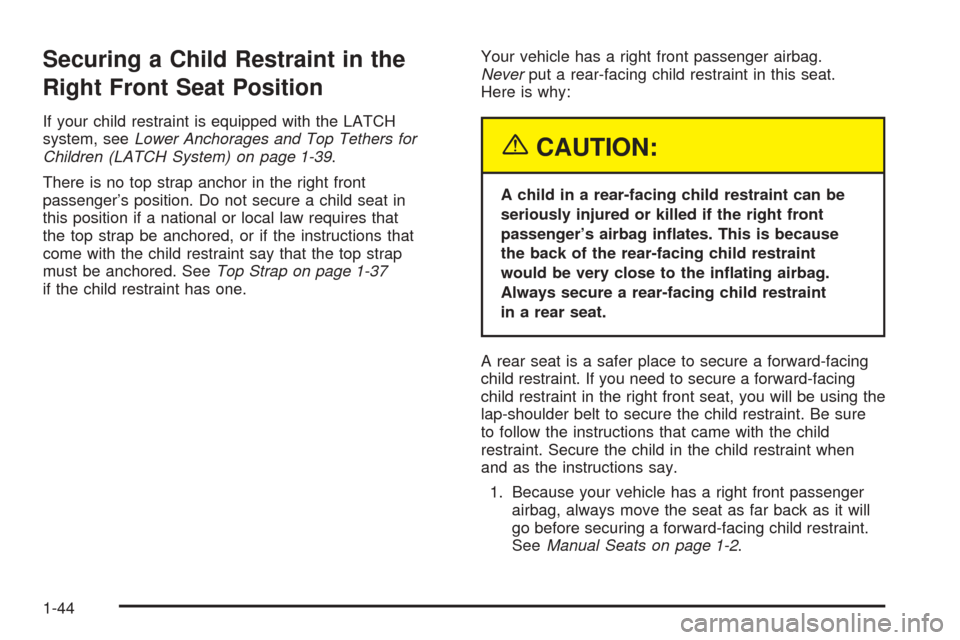
Securing a Child Restraint in the
Right Front Seat Position
If your child restraint is equipped with the LATCH
system, seeLower Anchorages and Top Tethers for
Children (LATCH System) on page 1-39.
There is no top strap anchor in the right front
passenger’s position. Do not secure a child seat in
this position if a national or local law requires that
the top strap be anchored, or if the instructions that
come with the child restraint say that the top strap
must be anchored. SeeTop Strap on page 1-37
if the child restraint has one.Your vehicle has a right front passenger airbag.
Neverput a rear-facing child restraint in this seat.
Here is why:
{CAUTION:
A child in a rear-facing child restraint can be
seriously injured or killed if the right front
passenger’s airbag in�ates. This is because
the back of the rear-facing child restraint
would be very close to the in�ating airbag.
Always secure a rear-facing child restraint
in a rear seat.
A rear seat is a safer place to secure a forward-facing
child restraint. If you need to secure a forward-facing
child restraint in the right front seat, you will be using the
lap-shoulder belt to secure the child restraint. Be sure
to follow the instructions that came with the child
restraint. Secure the child in the child restraint when
and as the instructions say.
1. Because your vehicle has a right front passenger
airbag, always move the seat as far back as it will
go before securing a forward-facing child restraint.
SeeManual Seats on page 1-2.
1-44
Page 51 of 316
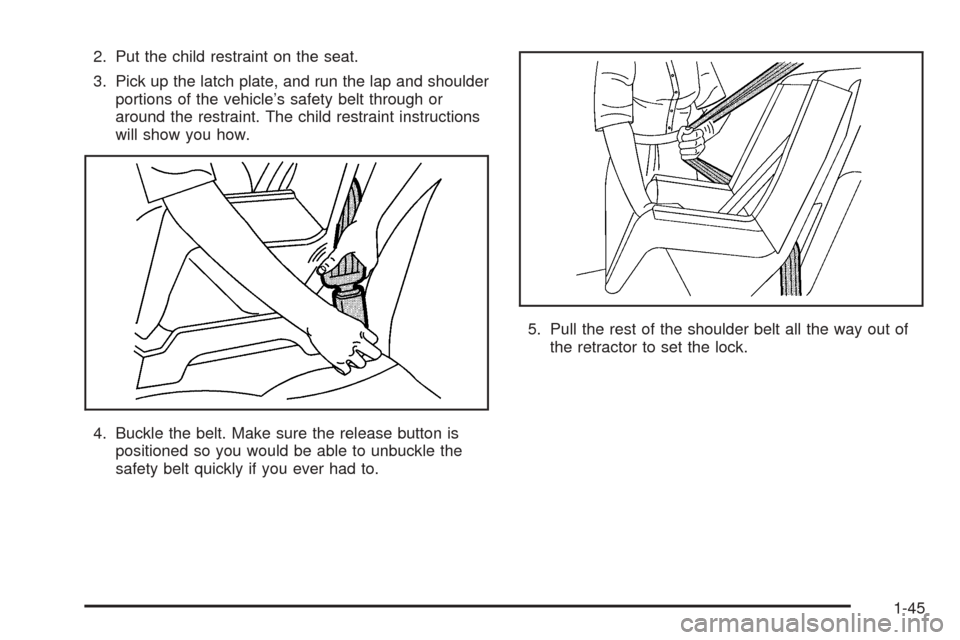
2. Put the child restraint on the seat.
3. Pick up the latch plate, and run the lap and shoulder
portions of the vehicle’s safety belt through or
around the restraint. The child restraint instructions
will show you how.
4. Buckle the belt. Make sure the release button is
positioned so you would be able to unbuckle the
safety belt quickly if you ever had to.5. Pull the rest of the shoulder belt all the way out of
the retractor to set the lock.
1-45
Page 175 of 316
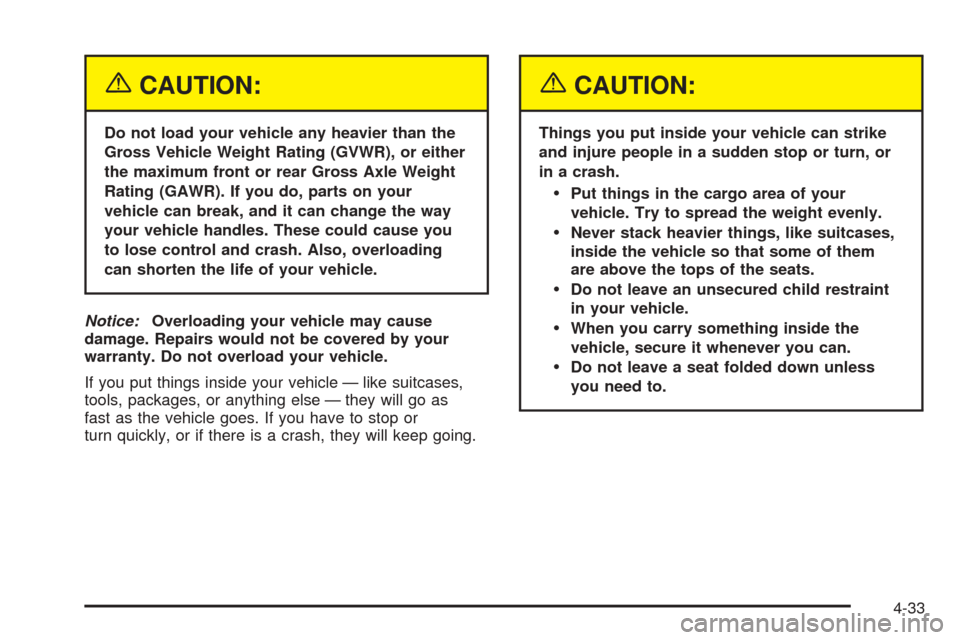
{CAUTION:
Do not load your vehicle any heavier than the
Gross Vehicle Weight Rating (GVWR), or either
the maximum front or rear Gross Axle Weight
Rating (GAWR). If you do, parts on your
vehicle can break, and it can change the way
your vehicle handles. These could cause you
to lose control and crash. Also, overloading
can shorten the life of your vehicle.
Notice:Overloading your vehicle may cause
damage. Repairs would not be covered by your
warranty. Do not overload your vehicle.
If you put things inside your vehicle — like suitcases,
tools, packages, or anything else — they will go as
fast as the vehicle goes. If you have to stop or
turn quickly, or if there is a crash, they will keep going.
{CAUTION:
Things you put inside your vehicle can strike
and injure people in a sudden stop or turn, or
in a crash.
Put things in the cargo area of your
vehicle. Try to spread the weight evenly.
Never stack heavier things, like suitcases,
inside the vehicle so that some of them
are above the tops of the seats.
Do not leave an unsecured child restraint
in your vehicle.
When you carry something inside the
vehicle, secure it whenever you can.
Do not leave a seat folded down unless
you need to.
4-33
Page 185 of 316
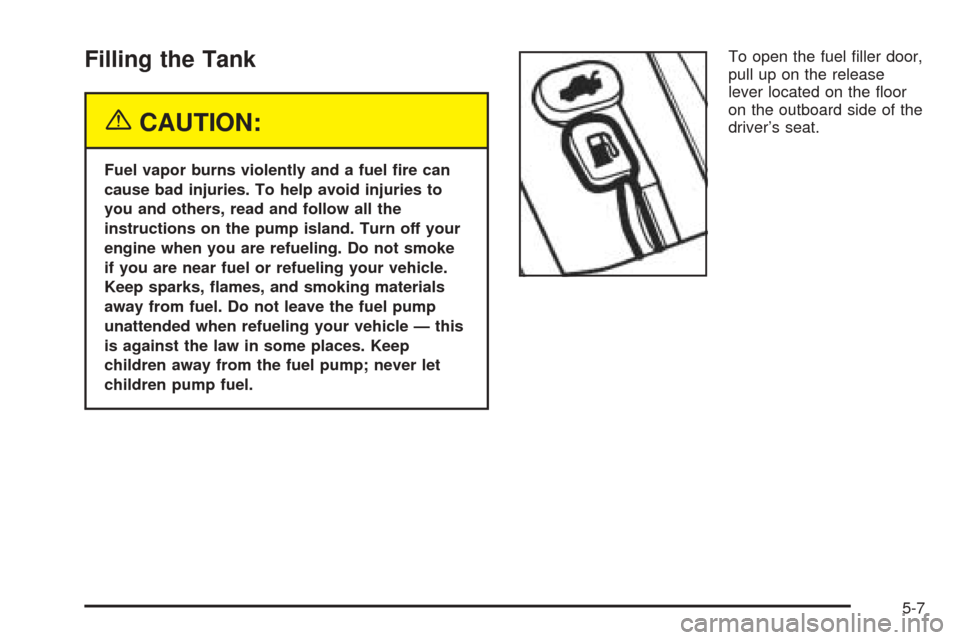
Filling the Tank
{CAUTION:
Fuel vapor burns violently and a fuel �re can
cause bad injuries. To help avoid injuries to
you and others, read and follow all the
instructions on the pump island. Turn off your
engine when you are refueling. Do not smoke
if you are near fuel or refueling your vehicle.
Keep sparks, �ames, and smoking materials
away from fuel. Do not leave the fuel pump
unattended when refueling your vehicle — this
is against the law in some places. Keep
children away from the fuel pump; never let
children pump fuel.To open the fuel filler door,
pull up on the release
lever located on the floor
on the outboard side of the
driver’s seat.
5-7
Page 307 of 316
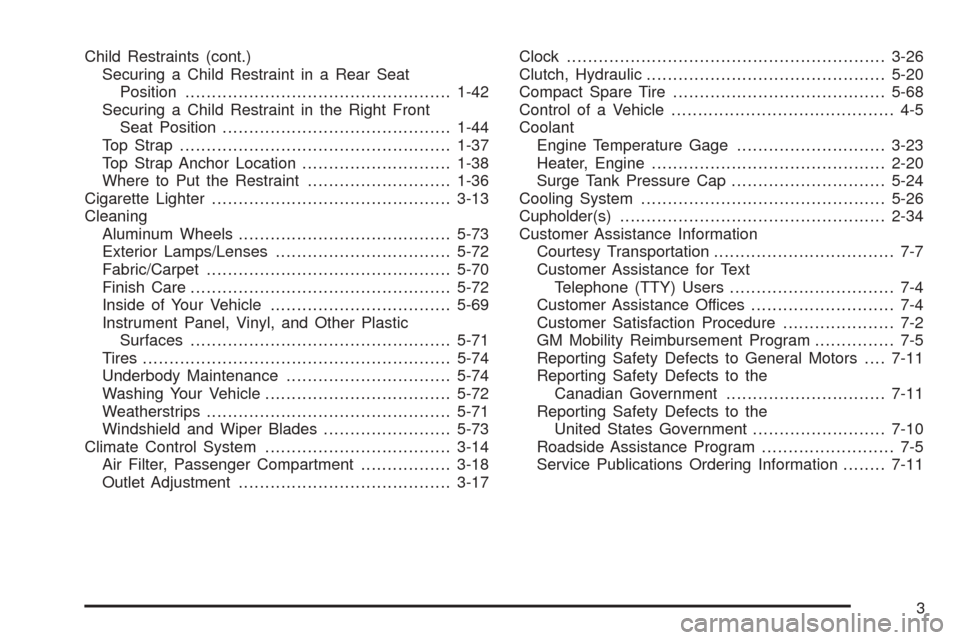
Child Restraints (cont.)
Securing a Child Restraint in a Rear Seat
Position..................................................1-42
Securing a Child Restraint in the Right Front
Seat Position...........................................1-44
Top Strap...................................................1-37
Top Strap Anchor Location............................1-38
Where to Put the Restraint...........................1-36
Cigarette Lighter.............................................3-13
Cleaning
Aluminum Wheels........................................5-73
Exterior Lamps/Lenses.................................5-72
Fabric/Carpet..............................................5-70
Finish Care.................................................5-72
Inside of Your Vehicle..................................5-69
Instrument Panel, Vinyl, and Other Plastic
Surfaces.................................................5-71
Tires..........................................................5-74
Underbody Maintenance...............................5-74
Washing Your Vehicle...................................5-72
Weatherstrips..............................................5-71
Windshield and Wiper Blades........................5-73
Climate Control System...................................3-14
Air Filter, Passenger Compartment.................3-18
Outlet Adjustment........................................3-17Clock............................................................3-26
Clutch, Hydraulic.............................................5-20
Compact Spare Tire........................................5-68
Control of a Vehicle.......................................... 4-5
Coolant
Engine Temperature Gage............................3-23
Heater, Engine............................................2-20
Surge Tank Pressure Cap.............................5-24
Cooling System..............................................5-26
Cupholder(s)..................................................2-34
Customer Assistance Information
Courtesy Transportation.................................. 7-7
Customer Assistance for Text
Telephone (TTY) Users............................... 7-4
Customer Assistance Offices........................... 7-4
Customer Satisfaction Procedure..................... 7-2
GM Mobility Reimbursement Program............... 7-5
Reporting Safety Defects to General Motors....7-11
Reporting Safety Defects to the
Canadian Government..............................7-11
Reporting Safety Defects to the
United States Government.........................7-10
Roadside Assistance Program......................... 7-5
Service Publications Ordering Information........7-11
3
Page 310 of 316
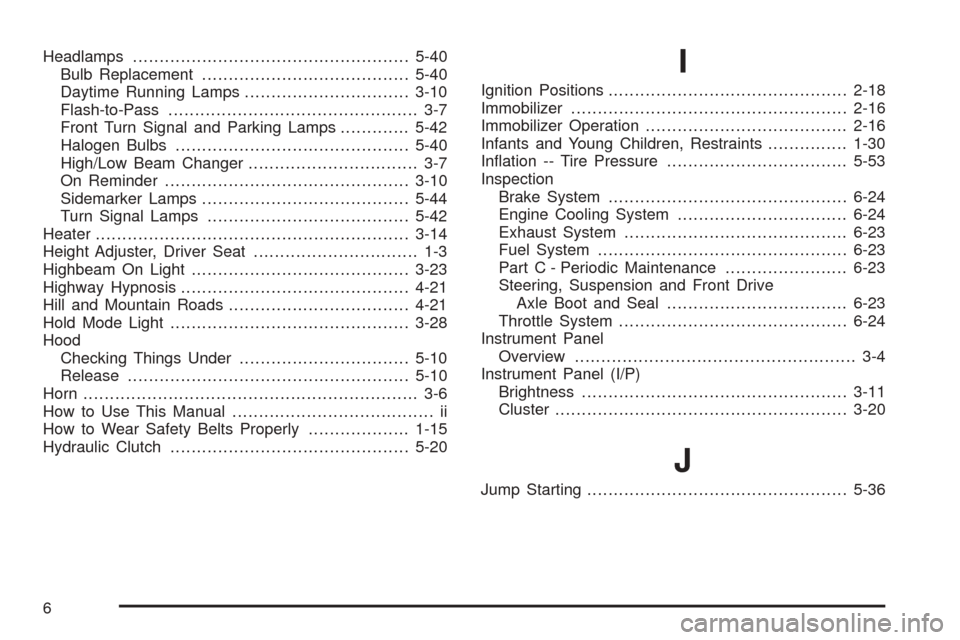
Headlamps....................................................5-40
Bulb Replacement.......................................5-40
Daytime Running Lamps...............................3-10
Flash-to-Pass............................................... 3-7
Front Turn Signal and Parking Lamps.............5-42
Halogen Bulbs............................................5-40
High/Low Beam Changer................................ 3-7
On Reminder..............................................3-10
Sidemarker Lamps.......................................5-44
Turn Signal Lamps......................................5-42
Heater...........................................................3-14
Height Adjuster, Driver Seat............................... 1-3
Highbeam On Light.........................................3-23
Highway Hypnosis...........................................4-21
Hill and Mountain Roads..................................4-21
Hold Mode Light.............................................3-28
Hood
Checking Things Under................................5-10
Release.....................................................5-10
Horn............................................................... 3-6
How to Use This Manual...................................... ii
How to Wear Safety Belts Properly...................1-15
Hydraulic Clutch.............................................5-20I
Ignition Positions.............................................2-18
Immobilizer....................................................2-16
Immobilizer Operation......................................2-16
Infants and Young Children, Restraints...............1-30
Inflation -- Tire Pressure..................................5-53
Inspection
Brake System.............................................6-24
Engine Cooling System................................6-24
Exhaust System..........................................6-23
Fuel System...............................................6-23
Part C - Periodic Maintenance.......................6-23
Steering, Suspension and Front Drive
Axle Boot and Seal..................................6-23
Throttle System...........................................6-24
Instrument Panel
Overview..................................................... 3-4
Instrument Panel (I/P)
Brightness..................................................3-11
Cluster.......................................................3-20
J
Jump Starting.................................................5-36
6
Page 312 of 316
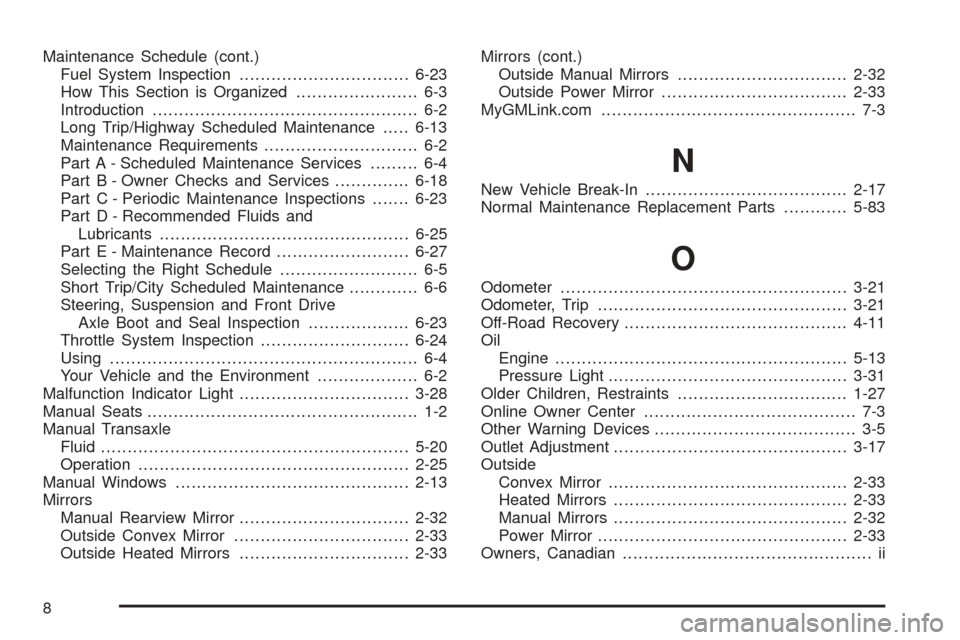
Maintenance Schedule (cont.)
Fuel System Inspection................................6-23
How This Section is Organized....................... 6-3
Introduction.................................................. 6-2
Long Trip/Highway Scheduled Maintenance.....6-13
Maintenance Requirements............................. 6-2
Part A - Scheduled Maintenance Services......... 6-4
Part B - Owner Checks and Services..............6-18
Part C - Periodic Maintenance Inspections.......6-23
Part D - Recommended Fluids and
Lubricants...............................................6-25
Part E - Maintenance Record.........................6-27
Selecting the Right Schedule.......................... 6-5
Short Trip/City Scheduled Maintenance............. 6-6
Steering, Suspension and Front Drive
Axle Boot and Seal Inspection...................6-23
Throttle System Inspection............................6-24
Using.......................................................... 6-4
Your Vehicle and the Environment................... 6-2
Malfunction Indicator Light................................3-28
Manual Seats................................................... 1-2
Manual Transaxle
Fluid..........................................................5-20
Operation...................................................2-25
Manual Windows............................................2-13
Mirrors
Manual Rearview Mirror................................2-32
Outside Convex Mirror.................................2-33
Outside Heated Mirrors................................2-33Mirrors (cont.)
Outside Manual Mirrors................................2-32
Outside Power Mirror...................................2-33
MyGMLink.com................................................ 7-3
N
New Vehicle Break-In......................................2-17
Normal Maintenance Replacement Parts............5-83
O
Odometer......................................................3-21
Odometer, Trip...............................................3-21
Off-Road Recovery..........................................4-11
Oil
Engine.......................................................5-13
Pressure Light.............................................3-31
Older Children, Restraints................................1-27
Online Owner Center........................................ 7-3
Other Warning Devices...................................... 3-5
Outlet Adjustment............................................3-17
Outside
Convex Mirror.............................................2-33
Heated Mirrors............................................2-33
Manual Mirrors............................................2-32
Power Mirror...............................................2-33
Owners, Canadian............................................... ii
8
Page 314 of 316
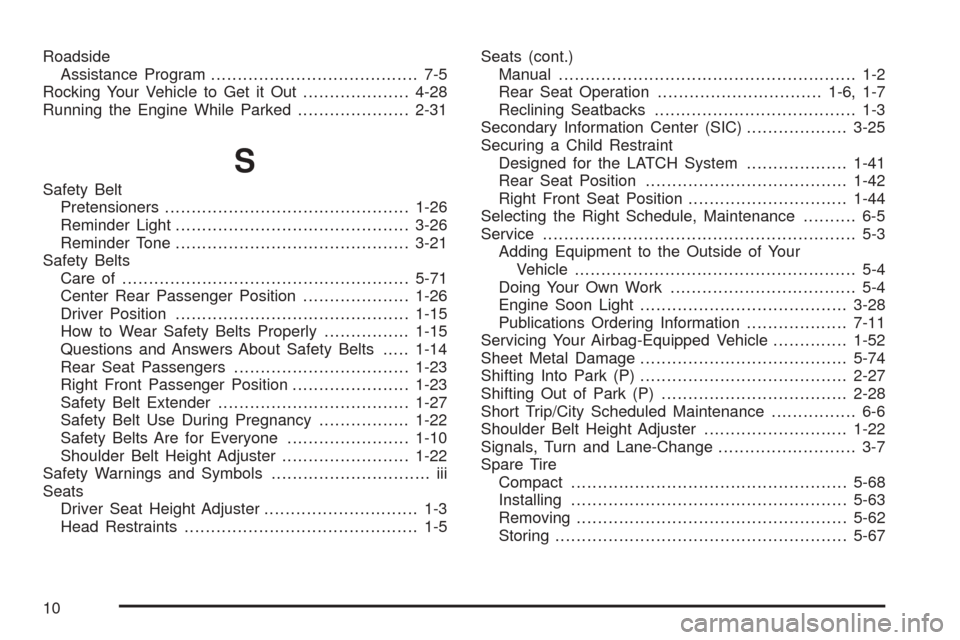
Roadside
Assistance Program....................................... 7-5
Rocking Your Vehicle to Get it Out....................4-28
Running the Engine While Parked.....................2-31
S
Safety Belt
Pretensioners..............................................1-26
Reminder Light............................................3-26
Reminder Tone............................................3-21
Safety Belts
Care of......................................................5-71
Center Rear Passenger Position....................1-26
Driver Position............................................1-15
How to Wear Safety Belts Properly................1-15
Questions and Answers About Safety Belts.....1-14
Rear Seat Passengers.................................1-23
Right Front Passenger Position......................1-23
Safety Belt Extender....................................1-27
Safety Belt Use During Pregnancy.................1-22
Safety Belts Are for Everyone.......................1-10
Shoulder Belt Height Adjuster........................1-22
Safety Warnings and Symbols.............................. iii
Seats
Driver Seat Height Adjuster............................. 1-3
Head Restraints............................................ 1-5Seats (cont.)
Manual........................................................ 1-2
Rear Seat Operation...............................1-6, 1-7
Reclining Seatbacks...................................... 1-3
Secondary Information Center (SIC)...................3-25
Securing a Child Restraint
Designed for the LATCH System...................1-41
Rear Seat Position......................................1-42
Right Front Seat Position..............................1-44
Selecting the Right Schedule, Maintenance.......... 6-5
Service........................................................... 5-3
Adding Equipment to the Outside of Your
Vehicle..................................................... 5-4
Doing Your Own Work................................... 5-4
Engine Soon Light.......................................3-28
Publications Ordering Information...................7-11
Servicing Your Airbag-Equipped Vehicle..............1-52
Sheet Metal Damage.......................................5-74
Shifting Into Park (P).......................................2-27
Shifting Out of Park (P)...................................2-28
Short Trip/City Scheduled Maintenance................ 6-6
Shoulder Belt Height Adjuster...........................1-22
Signals, Turn and Lane-Change.......................... 3-7
Spare Tire
Compact....................................................5-68
Installing....................................................5-63
Removing...................................................5-62
Storing.......................................................5-67
10